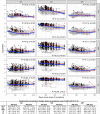Sustained seropositivity up to 20.5 months after COVID-19
- PMID: 36224590
- PMCID: PMC9556137
- DOI: 10.1186/s12916-022-02570-3
Sustained seropositivity up to 20.5 months after COVID-19
Abstract
This study evaluated the persistence of IgM, IgA, and IgG to SARS-CoV-2 spike and nucleocapsid antigens up to 616 days since the onset of symptoms in a longitudinal cohort of 247 primary health care workers from Barcelona, Spain, followed up since the start of the pandemic. The study also assesses factors affecting antibody levels, including comorbidities and the responses to variants of concern as well as the frequency of reinfections. Despite a gradual and significant decline in antibody levels with time, seropositivity to five SARS-CoV-2 antigens combined was always higher than 90% over the whole study period. In a subset of 23 participants who had not yet been vaccinated by November 2021, seropositivity remained at 95.65% (47.83% IgM, 95.65% IgA, 95.65% IgG). IgG seropositivity against Alpha and Delta predominant variants was comparable to that against the Wuhan variant, while it was lower for Gamma and Beta (minority) variants and for IgA and IgM. Antibody levels at the time point closest to infection were associated with age, smoking, obesity, hospitalization, fever, anosmia/hypogeusia, chest pain, and hypertension in multivariable regression models. Up to 1 year later, just before the massive roll out of vaccination, antibody levels were associated with age, occupation, hospitalization, duration of symptoms, anosmia/hypogeusia, fever, and headache. In addition, tachycardia and cutaneous symptoms associated with slower antibody decay, and oxygen supply with faster antibody decay. Eight reinfections (3.23%) were detected in low responders, which is consistent with a sustained protective role for anti-spike naturally acquired antibodies. Stable persistence of IgG and IgA responses and cross-recognition of the predominant variants circulating in the 2020-2021 period indicate long-lasting and largely variant-transcending humoral immunity in the initial 20.5 months of the pandemic, in the absence of vaccination.
Keywords: Antibody; COVID-19; Duration; Health care workers; IgA; IgG; IgM; Kinetics; SARS-CoV-2; Seroprevalence.
© 2022. The Author(s).
Conflict of interest statement
The authors declare that they have no competing interests.
Figures

Similar articles
-
Eleven-month longitudinal study of antibodies in SARS-CoV-2 exposed and naïve primary health care workers upon COVID-19 vaccination.Immunology. 2022 Dec;167(4):528-543. doi: 10.1111/imm.13551. Epub 2022 Sep 6. Immunology. 2022. PMID: 36065677
-
Persistence and baseline determinants of seropositivity and reinfection rates in health care workers up to 12.5 months after COVID-19.BMC Med. 2021 Jun 28;19(1):155. doi: 10.1186/s12916-021-02032-2. BMC Med. 2021. PMID: 34183003 Free PMC article.
-
SARS-CoV-2 Infection-and mRNA Vaccine-induced Humoral Immunity among Schoolchildren in Hawassa, Ethiopia.Front Immunol. 2023 Jun 15;14:1163688. doi: 10.3389/fimmu.2023.1163688. eCollection 2023. Front Immunol. 2023. PMID: 37398668 Free PMC article.
-
Kinetics of humoral immune response over 17 months of COVID-19 pandemic in a large cohort of healthcare workers in Spain: the ProHEpiC-19 study.BMC Infect Dis. 2022 Sep 3;22(1):721. doi: 10.1186/s12879-022-07696-6. BMC Infect Dis. 2022. PMID: 36057544 Free PMC article.
-
SARS-CoV-2 antibody dynamics over time and risk factors associated with infection and long COVID-19 symptoms in large working environments.J Intern Med. 2023 Jun;293(6):763-781. doi: 10.1111/joim.13637. Epub 2023 Apr 17. J Intern Med. 2023. PMID: 37024264
Cited by
-
Seroprevalence and socioeconomic impact of the first SARS-CoV-2 infection wave in a small town in Navarre, Spain.Sci Rep. 2023 Mar 8;13(1):3862. doi: 10.1038/s41598-023-30542-x. Sci Rep. 2023. PMID: 36890175 Free PMC article.
-
Nasopharyngeal Viral Load Is the Major Driver of Incident Antibody Immune Response to SARS-CoV-2 Infection.Open Forum Infect Dis. 2023 Dec 2;10(12):ofad598. doi: 10.1093/ofid/ofad598. eCollection 2023 Dec. Open Forum Infect Dis. 2023. PMID: 38111750 Free PMC article.
-
Correlates of protection and determinants of SARS-CoV-2 breakthrough infections 1 year after third dose vaccination.BMC Med. 2024 Mar 8;22(1):103. doi: 10.1186/s12916-024-03304-3. BMC Med. 2024. PMID: 38454385 Free PMC article.
-
Dynamics of cytokine and antibody responses in community versus hospital SARS-CoV-2 infections.Front Immunol. 2024 Nov 22;15:1468871. doi: 10.3389/fimmu.2024.1468871. eCollection 2024. Front Immunol. 2024. PMID: 39650666 Free PMC article.
-
Waning of anti-SARS-CoV-2 antibodies after the first wave of the COVID-19 pandemic in 2020: A 12-month-evaluation in three population-based European studies.PLoS One. 2025 May 9;20(5):e0320196. doi: 10.1371/journal.pone.0320196. eCollection 2025. PLoS One. 2025. PMID: 40344145 Free PMC article.
References
-
- Pradenas E, Trinité B, Urrea V, Marfil S, Tarrés-Freixas F, Ortiz R, Rovirosa C, Rodon J, Vergara-Alert J, Segalés J, Guallar V, Valencia A, Izquierdo-Useros N, Noguera-Julian M, Carrillo J, Paredes R, Mateu L, Chamorro A, Toledo R, Massanella M, Clotet B, Blanco J. Clinical course impacts early kinetics,magnitude, and amplitude of SARS-CoV-2 neutralizing antibodies beyond 1 year after infection. J Cell Rep Med. 2022;3(2):100523. 10.1016/j.xcrm.2022.100523. - PMC - PubMed
Publication types
MeSH terms
Substances
Grants and funding
LinkOut - more resources
Full Text Sources
Medical
Miscellaneous

